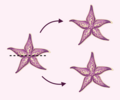Starfish regeneration
Starfish Regeneration
Starfish, or sea stars, are marine invertebrates belonging to the class Asteroidea. They are known for their remarkable ability to regenerate lost body parts, a process that has fascinated scientists and laypeople alike. This article delves into the mechanisms, extent, and implications of starfish regeneration.
Overview[edit]
Starfish regeneration refers to the process by which these creatures can regrow lost arms and, in some cases, entire bodies from a single arm. This ability varies among different species of starfish, with some capable of regenerating more rapidly and completely than others.
Mechanism[edit]
The mechanism of starfish regeneration involves complex biological processes that begin at the cellular level. When a starfish loses an arm, cells near the wound site start to dedifferentiate, transforming into a type of cell that can proliferate and grow into different kinds of tissues. These cells, known as neoblasts, are akin to stem cells found in other animals. They divide and differentiate to form new tissues, including muscles, nerves, and skin, eventually regrowing the lost arm.
Genetic Factors[edit]
Recent studies have identified several genes and molecular pathways that play crucial roles in the regeneration process. These include genes involved in wound healing, cell proliferation, and differentiation. Understanding these genetic factors is crucial for unraveling the mysteries of regeneration and could have implications for regenerative medicine in humans.
Environmental Factors[edit]
Environmental conditions such as temperature, salinity, and the availability of food can influence the rate of starfish regeneration. Optimal conditions promote faster healing and growth, while adverse conditions can slow down or even halt the process.
Implications for Regenerative Medicine[edit]
The study of starfish regeneration has significant implications for regenerative medicine, a field that seeks to develop therapies for repairing or replacing damaged human tissues and organs. By understanding the mechanisms behind starfish regeneration, scientists hope to uncover new strategies for stimulating regeneration in humans, potentially leading to treatments for a wide range of injuries and diseases.
Conservation and Ecological Impact[edit]
Starfish play a crucial role in marine ecosystems, often serving as keystone species. Their ability to regenerate not only ensures their survival but also maintains the balance of marine habitats. However, this remarkable ability can also pose challenges for managing populations of invasive starfish species, such as the crown-of-thorns starfish, which can devastate coral reefs.
Conclusion[edit]
Starfish regeneration remains a fascinating area of study with far-reaching implications. As research continues to uncover the secrets of this remarkable process, it holds the promise of contributing to advances in medicine and providing insights into the conservation of marine ecosystems.

Starfish_regeneration[edit]
-
Common starfish, Asterias rubens
-
Simple sea star body plan
-
Starfish unidirectional regeneration
-
Disk-dependent bidirectional regeneration
-
Disk-independent bidirectional regeneration
-
Sea star regenerating legs
-
Starfish_regeneration
-
Autotomy in starfish
-
Fission in starfish
Ad. Transform your life with W8MD's Budget GLP-1 injections from $75


W8MD offers a medical weight loss program to lose weight in Philadelphia. Our physician-supervised medical weight loss provides:
- Weight loss injections in NYC (generic and brand names):
- Zepbound / Mounjaro, Wegovy / Ozempic, Saxenda
- Most insurances accepted or discounted self-pay rates. We will obtain insurance prior authorizations if needed.
- Generic GLP1 weight loss injections from $75 for the starting dose.
- Also offer prescription weight loss medications including Phentermine, Qsymia, Diethylpropion, Contrave etc.
NYC weight loss doctor appointmentsNYC weight loss doctor appointments
Start your NYC weight loss journey today at our NYC medical weight loss and Philadelphia medical weight loss clinics.
- Call 718-946-5500 to lose weight in NYC or for medical weight loss in Philadelphia 215-676-2334.
- Tags:NYC medical weight loss, Philadelphia lose weight Zepbound NYC, Budget GLP1 weight loss injections, Wegovy Philadelphia, Wegovy NYC, Philadelphia medical weight loss, Brookly weight loss and Wegovy NYC
|
WikiMD's Wellness Encyclopedia |
| Let Food Be Thy Medicine Medicine Thy Food - Hippocrates |
Medical Disclaimer: WikiMD is not a substitute for professional medical advice. The information on WikiMD is provided as an information resource only, may be incorrect, outdated or misleading, and is not to be used or relied on for any diagnostic or treatment purposes. Please consult your health care provider before making any healthcare decisions or for guidance about a specific medical condition. WikiMD expressly disclaims responsibility, and shall have no liability, for any damages, loss, injury, or liability whatsoever suffered as a result of your reliance on the information contained in this site. By visiting this site you agree to the foregoing terms and conditions, which may from time to time be changed or supplemented by WikiMD. If you do not agree to the foregoing terms and conditions, you should not enter or use this site. See full disclaimer.
Credits:Most images are courtesy of Wikimedia commons, and templates, categories Wikipedia, licensed under CC BY SA or similar.
Translate this page: - East Asian
中文,
日本,
한국어,
South Asian
हिन्दी,
தமிழ்,
తెలుగు,
Urdu,
ಕನ್ನಡ,
Southeast Asian
Indonesian,
Vietnamese,
Thai,
မြန်မာဘာသာ,
বাংলা
European
español,
Deutsch,
français,
Greek,
português do Brasil,
polski,
română,
русский,
Nederlands,
norsk,
svenska,
suomi,
Italian
Middle Eastern & African
عربى,
Turkish,
Persian,
Hebrew,
Afrikaans,
isiZulu,
Kiswahili,
Other
Bulgarian,
Hungarian,
Czech,
Swedish,
മലയാളം,
मराठी,
ਪੰਜਾਬੀ,
ગુજરાતી,
Portuguese,
Ukrainian








